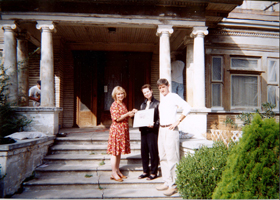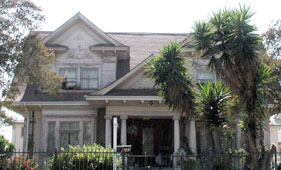Toberman House Saved At Last Minute
Success again for Hollywood Heritage! In keeping with a
tradition of practicing what we preach, Hollywood Heritage has succeeded in
saving the home of 2 time
Upon learning of the impending sale of this landmark to
apartment developers, who planned to demolish it, Hollywood Heritage had
quickly prepared a winning Cultural Heritage nomination. With the help of
Councilman Tom LaBonge in calendaring the motion (and the moral support of
Councilman Eric Garcetti), the house was declared
Monument #769 on October 29,2003. But the owners,
still eager for their sale, quickly listed the home aga in for sale.
in for sale.
Fran commissioned an
appraisal at her own expense from an appraiser specializing in both historic
properties and in vacant land. They needed to insure that a valid price could
be offered if an appropriate non-profit buyer could be found. Fran also advised
the broker on how to keep the substandard structure from being grabbed by the
City under a pending “REAP” action, which would have scared off buyers and
lenders and hurried the home’s demolition.
Kay’s diligence paid
off. The broker courteously called March 23, 2004 to let her know that the
property had been relisted, and that offers were
pouring in. Hollywood Heritage had shown such good faith – our goal in every
preservationist vs. landmark demolition situation – that the broker returned
the good faith. Kay immediately called
There are many other heroes in this tale:
· Michael Mekeel, Fran’s husband and likely the most serious
preservationist in
· Dave
Monks and both HUNC (Hollywood United Neighborhood Council) and GGPNC (Greater
· Maria Kushko, former owner of the house, and her son Ted Wojdlya trusted Fran over a nailbiting
escrow period, extending deadlines, and giving Fran free rein to repair the
house while they still owned it and lived in it so it could be saved
· Sally Beaudette, Hollywood Heritage Advisory Board member, who
immediately understood the importance of the house to
· Mary Deckeback, First Republic Bank, arranged real estate
financing for a property which was long on emotional history but short on just
about everything else
· Martin Eli Weil donated
his services for an historic paint analysis
·
· Fran’s real estate
broker waived his real estate commission
· Larry Kaplan and
Jennifer Hranilovich of the Trust for Public Land,
who offered gap financing and assisted in the search for a non-profit buyer
· Don Scott of First
Financial Bancorp, whose commitment to
· Dan
O’Connell and Vicki Gill, appraisers, for seeing a future in the past.
The escrow period was a cliff hanger, and not just because
it became increasingly clear that there was going to be no non-profit buyer who
could perform within the escrow time limits .
.
Two huge crises loomed.
The juggernaut of the
The largest crisis was obtaining financing. In the world
of commercial real estate, a clean apartment building with new wiring and
plumbing and a long steady rental history is an easy sell to a bank. A house
that looks like its from a horror film, is about to be
grabbed by the City, and is occupied by two family members and two boarders is
a recipe for bank rejection. Fran’s long time lender drove by the house and
backed out.
Mary Deckeback of First Republic
Bank went the extra mile to help Fran build a case directly with the owners of
the bank, showing that Fran’s long record in real estate development and in
restoration of landmarks boded well for the bank and for
Just as people look at the El Capitan Theater, and the
Cinerama Dome, and many historic buildings in